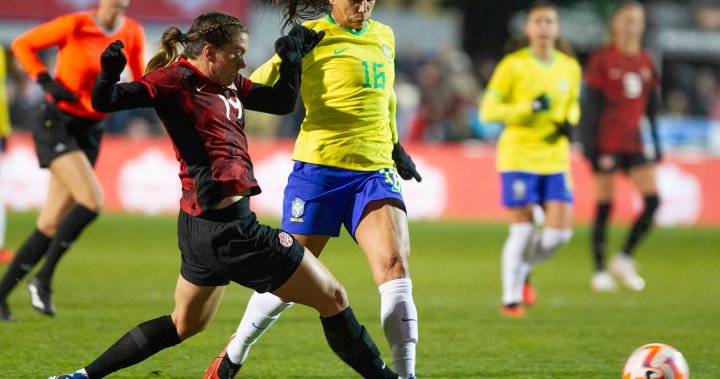Women’s professional sports is a growing phenomenon worldwide, and Canada is increasingly joining in the action.
After the launch of the Professional Women’s Hockey League this year with three of the six teams from Canadian cities, another six Canadian women’s teams have applied to join a new national Division 1 women’s soccer league in the country.
Called Project 8, it will be the first domestic professional women’s soccer league Canada has ever seen and is a “big deal,” women’s sports advocates told Global News.
So far, Vancouver, Toronto and Calgary have announced they have applied to the league, and three other teams will be revealed in the coming weeks, according to Project 8. The league is set to launch in 2025 and has Canadian Tire, CIBC, DoorDash and Air Canada as founding partners.
“The timing (for its launch) couldn’t be better with the growth of viewership and popularity of women’s sports in general,” Kim Brassor, the founder and executive director of Oakville, Ont.-based Future Girls Soccer, told Global News.
“If the right business partners come along and players come along, I think it’s going to be a terrific venture for Canada Soccer.”

Brassor helps coach girls ages eight to 12 in soccer, and said having a professional league in Canada will be a huge inspiration for players. Before Project 8, the only hope for playing the sport professionally would be to go to other countries to play in their leagues, she said.
Breaking news from Canada and around the world
sent to your email, as it happens.
Now the goal of playing professionally will be much more tangible and provide young players with role models, according to Brassor.
The new league is being created by retired Olympic player Diana Matheson and her business partner, Thomas Gilbert. It comes as women’s sports is rapidly gaining popularity around the world, according to Allison Sandmeyer-Graves, the CEO of non-profit Canadian Women and Sport.
“It’s a global phenomenon,” she said. “The fandom is growing in terms of the viewership online, on TV, engagement on social media, attendance at events.”
Nielsen reported in July 2023 that interest in women’s sports is growing at a “meteoric pace,” with the final game of the NCAA Women’s Division between Iowa and LSU drawing in a record-breaking 9.9 million views, up 103 per cent from the year before. Deloitte has predicted that women’s elite sports will surpase US$1 billion in revenue in 2024 for the first time.
Sandmeyer-Graves said Canada is actually behind in terms of women’s sports offerings compared to other places such as the U.S. and Europe, and says there is a massive opportunity for investment and partnerships. She said women athletes are now building their own profiles and fanbases similar to how male athletes have done for decades — and brands are taking notice.
The new league will only help with growth by creating more visibility and air time, she said.
“Investors seeing the business opportunity that (women’s sports) represents and starting to put their money toward it is making a profound difference,” she said. “There’s a tremendous business opportunity here that has not been tapped into yet.”

Similar to how local sports, such as the Raptors G-League in Mississauga, are making inroads of their own, women’s sports provides its own twist that fans seem to be eating up.
Brassor said stands are constantly filled at games, and often it is families who hope to provide some inspiration for their children. But it isn’t only inspiration on show but actual talent, she noted.
“It’s a great game,” she said. “When you watch it, you’re entertained.”
There are still obstacles to women’s sports, though. Sandmeyer-Graves mentioned that sports has been dominated by men for so long that there is “gender bias” baked into the decision making and policies, also given leadership in sports is still very much male.
Women’s sports — along with sports more broadly — also have faced high-profile sexual abuse and misconduct issues that have been unearthed in recent years, including in water polo, gymnastics and hockey.
Both Sandmeyer-Graves and Brassor say there is still a long way to go to eradicate the problem completely.
“We have to stand up for victims and give them a neutral spot where they can tell their truth without being victimized again,” Brassor said. “We’re still not there.”
© 2024 Global News, a division of Corus Entertainment Inc.












